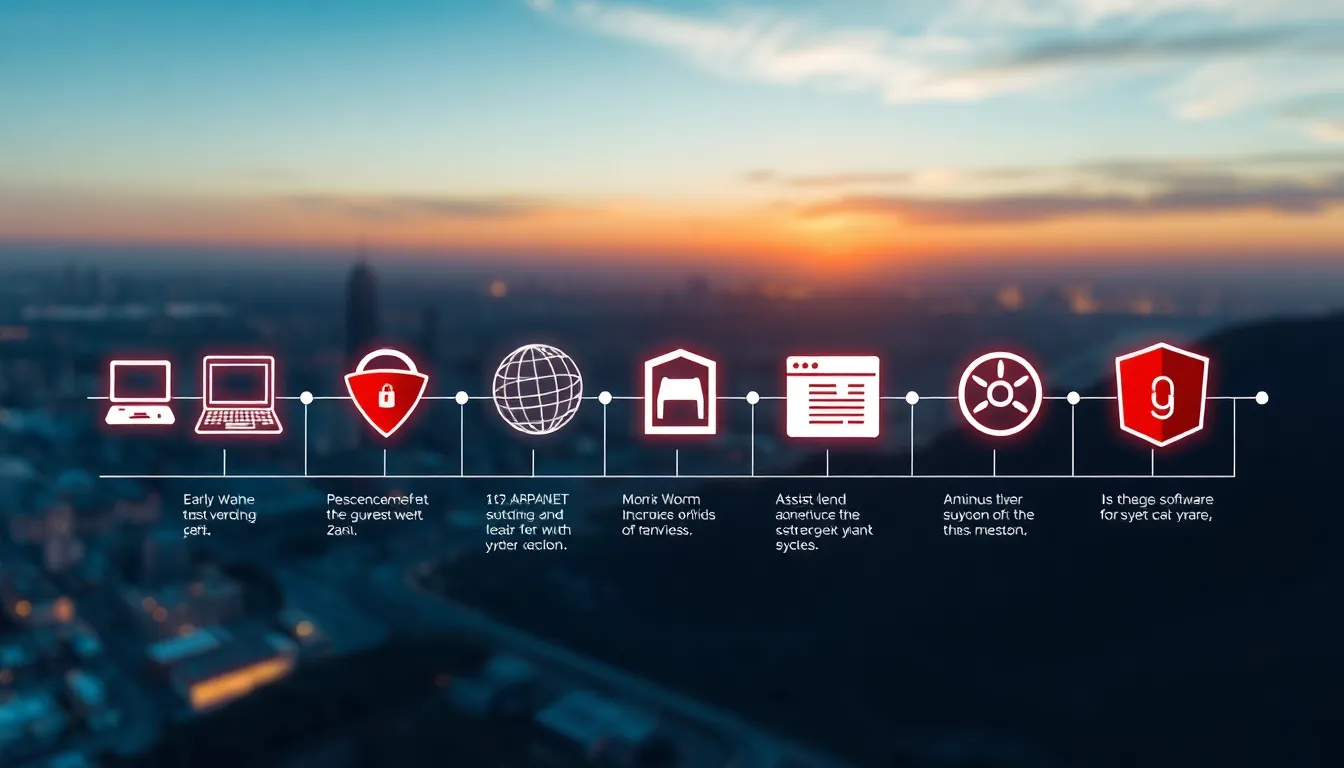Table of Contents
ToggleIn a world where everything from online shopping to banking happens at the click of a button, cyber security isn’t just a buzzword—it’s a necessity. Picture this: your favorite coffee shop suddenly becomes a hotspot for hackers, and your morning latte order gets intercepted. Scary, right? That’s why understanding the background of cyber security is crucial for anyone navigating the digital landscape.
Cyber security is like a digital bodyguard, tirelessly working behind the scenes to protect sensitive information from cyber villains. With the rise of sophisticated threats, knowing the ins and outs of this field can mean the difference between a secure online experience and a data disaster. So, buckle up as we dive into the fascinating world of cyber security and uncover what keeps your digital life safe from lurking dangers.
Overview of Cyber Security Background
Cyber security emerged as a crucial field in response to the increasing reliance on technology. It encompasses the protection of networks, systems, and data from unauthorized access or attacks. Hackers pose serious threats, targeting individuals and organizations alike. Notably, everyday locations, such as cafes and libraries, become hotspots for cyber threats.
Historical events highlight the evolution of cyber security. The 1988 Morris Worm marked one of the first major security breaches, affecting thousands of computers. This incident propelled the development of stronger security measures and protocols. As technology continued to advance, so did the strategies of cybercriminals.
Various types of cyber threats exist today. Malware, phishing, and ransomware represent some of the prevalent risks that individuals and businesses face. Users encounter phishing attempts via email, where attackers impersonate trusted organizations to steal sensitive information. Ransomware locks files and demands payment for access, putting organizations at risk of significant data loss.
Organizations prioritize cyber security by investing in comprehensive strategies. They implement firewalls, antivirus software, and regular system updates to safeguard against threats. Training employees on recognizing cyber threats contributes to a more secure environment. In fact, informed users often act as the first line of defense against cyber attacks.
Internationally, governments recognize the importance of cyber security, establishing laws and frameworks to combat cybercrime. The European Union’s General Data Protection Regulation (GDPR) mandates strict data protection requirements, holding organizations accountable for user data. Similarly, the Cybersecurity Information Sharing Act (CISA) in the United States encourages collaboration among businesses and government entities.
This comprehensive understanding of cyber security serves as a foundation for promoting safe online experiences. As digital activities become increasingly prevalent, awareness of potential threats and preventive measures remains vital.
History of Cyber Security

Cyber security has evolved significantly since its inception. Understanding its history provides insight into the current landscape.
Early Developments
The origins of cyber security trace back to the early 1970s. Network security models began forming with the introduction of ARPANET, which highlighted the need for data protection. In 1983, the first significant security breach occurred with the creation of the Morris Worm, affecting thousands of computers. This incident showcased vulnerabilities and prompted the development of stronger security protocols. By the late 1980s, organizations initiated the establishment of firewalls and antivirus software, laying the groundwork for future advancements in cyber security.
The Rise of Cyber Threats
Cyber threats expanded rapidly during the 1990s and 2000s. The proliferation of the internet facilitated increased access points for attackers. Malware and phishing schemes emerged, targeting both individuals and institutions. The notorious Melissa virus in 1999 infected over a million computers, demonstrating the damaging potential of such attacks. With the rise of e-commerce, ransomware also became prevalent, leading to financial losses for organizations. In response, businesses prioritized investment in comprehensive cyber defenses, highlighting the need for ongoing education and awareness to combat these challenges.
Key Concepts in Cyber Security
Cyber security comprises essential principles that ensure data protection and system integrity in a digital environment. Understanding these concepts forms a solid foundation for effective security measures.
Confidentiality, Integrity, and Availability
Confidentiality focuses on preventing unauthorized access to sensitive information. Integrity ensures that data remains accurate and unaltered during transmission and storage. Availability guarantees that information and resources are accessible to authorized users when needed. These three pillars, often referred to as the CIA triad, serve as the cornerstone of cyber security practices. Organizations implement measures like encryption and access controls to uphold confidentiality, integrity, and availability effectively.
Threats and Vulnerabilities
Numerous cyber threats jeopardize sensitive information and system functionality. Malware, such as viruses and spyware, can severely disrupt operations and lead to data breaches. Phishing attacks often deceive users into revealing personal information, resulting in financial loss. Recognizing vulnerabilities is crucial for strengthening defenses. Organizations assess their systems for weaknesses like outdated software or misconfigured configurations to effectively mitigate risks. Regular assessments and employee training reduce susceptibility to these evolving threats and enhance overall cyber security posture.
Importance of Cyber Security
Cyber security plays a vital role in today’s interconnected world. It safeguards sensitive data and ensures the integrity of systems.
Impact on Businesses
Businesses face significant challenges from cyber threats. A single breach can lead to financial losses averaging $3.86 million per incident, according to IBM. Organizations must invest in security measures like firewalls, intrusion detection systems, and employee training to mitigate risks. Moreover, many companies implement regular security audits to identify vulnerabilities. Cyber incidents not only disrupt operations but also damage reputations and erode customer trust. Firms recognize that a strong cyber security strategy not only protects assets but also acts as a competitive advantage.
Personal Privacy Concerns
Personal privacy is increasingly at risk in the digital age. Cyber attacks can expose individual data, with identity theft affecting about 14 million Americans in 2018 alone. Users must be vigilant in protecting their information against phishing scams and malware attacks. Implementing strong passwords and two-factor authentication is essential for enhancing online security. Awareness of potential threats fosters responsible online behavior. Individuals also benefit from understanding privacy settings on various platforms, which can help safeguard personal data.
Current Trends in Cyber Security
Modern cyber security practices evolve rapidly to address the complexities of today’s digital threats. Organizations focus on new strategies and tools to safeguard their information and infrastructure.
Emerging Technologies
Artificial intelligence strengthens threat detection and response capabilities. Machine learning algorithms analyze vast amounts of data, identifying anomalies that may signal breaches. Blockchain technology enhances data integrity, offering decentralized solutions to prevent tampering. Additionally, cloud security solutions address the rising shift to remote work, ensuring secure data storage and access. As IoT devices proliferate, securing these endpoints grows more critical. Companies that embrace these technologies increase their resilience against attacks.
Evolving Threat Landscape
Cyber threats continuously adapt, necessitating constant vigilance. Ransomware incidents have surged, with attackers targeting critical infrastructure, causing significant disruptions. Phishing schemes become increasingly sophisticated, convincing users to divulge sensitive information. Malware variants evolve, exploiting vulnerabilities in software as they emerge. Insider threats also pose risks, where employees inadvertently or deliberately compromise security. For organizations, awareness and proactive measures are paramount to counteract these threats effectively. Regular training and updated security protocols remain essential in addressing the shifting landscape.
Cyber security remains a vital aspect of navigating today’s digital landscape. As technology continues to evolve so do the threats that individuals and organizations face. It’s essential for everyone to stay informed about potential risks and adopt proactive measures to safeguard sensitive information.
Investing in robust security strategies and fostering a culture of awareness can significantly mitigate the impact of cyber threats. The ongoing development of new technologies offers both challenges and opportunities in enhancing security. By prioritizing education and vigilance, individuals and organizations can better protect themselves against the ever-changing landscape of cybercrime.




